

3 Steps to More Efficient, Healthier Running. Running is far and away the most impactful and damaging of the three triathlon disciplines.
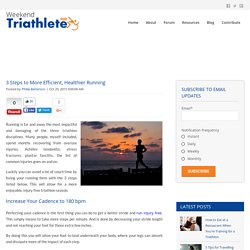
Many people, myself included, spend months recovering from overuse injuries. Achilles tendonitis, stress fractures, plantar fasciitis, the list of common injuries goes on and on. Master the walk/run strategy to become a faster triathlete - Run - 220Triathlon. Are you struggling with injury?
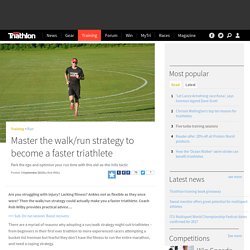
Lacking fitness? 10 Exercises You Can Do to Help Avoid Runner's Knee. If you’ve ever had runner’s knee, you know that it isn’t typical knee pain.
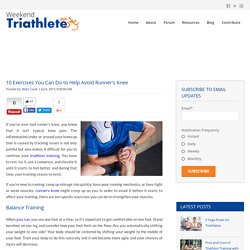
The inflammation under or around your kneecap that is caused by tracking issues is not only painful but also makes it difficult for you to continue your triathlon training. You have to rest, ice it, use a compress, and elevate it until it starts to feel better, and during that time, your training ceases to exist. □ Running more or running faster? Your HRV profile may predict how you would respond to different types of trg ❤️□ Everything Runners Need To Know About Interval Training. By Pete Magill, Published Jan. 6, 2016, Updated Feb. 1, 2016 at 3:15 PM UTC All types of interval training depend upon a correct pairing of the faster repetition and recovery interval to ensure maximum benefit.

Stuck On The Treadmill? Boost Speed With These 3 Workouts. Running on a treadmill is an unfortunate reality for many runners during the winter months.
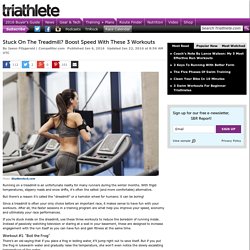
With frigid temperatures, slippery roads and snow drifts, it’s often the safest (and more comfortable) alternative. But there’s a reason it’s called the “dreadmill” or a hamster wheel for humans: it can be boring! Since a treadmill is often your only choice before an important race, it makes sense to have fun with your workouts. After all, the faster sessions in a training program are what help you improve your speed, economy and ultimately your race performances. If you’re stuck inside on the dreadmill, use these three workouts to reduce the boredom of running inside. Six Ways to Change Your Running for the Better in 2016. Since graduating in 2010 from the University of California-Davis, Goodman had waited for a moment like this.

In a four-year span, Goodman alternated solid months of training with doubts about whether professional running was a realistic dream, given her PR of 33:01 for 10,000 meters. Full-time work beckoned. Goodman didn’t give up. She took a big leap. She trained for a marathon for the first time. “The last 100 meters of that race is something I will remember to the end,” Goodman says. One-Hour Workout: Head For The Hills, Inside. Every Tuesday we’ll feature a different coach’s workout you can complete in 60 minutes (or less!).

This week’s treadmill workout comes from Lauren Updyke, a USAT Level I coach for Base Tri-Fitness in Columbus, Ohio. Updyke created this indoor strength-building workout with fellow Midwestern athletes in mind who might also have difficulty running in the snow. The Perfect Running Interval. High-intensity interval sessions are key for boosting fitness.

Here’s how to work them into your training. While endurance buffs often revel in long, slow runs, any good training regimen will also include some high-intensity sessions. This often comes in the form of interval training, which can create significant jumps in fitness. “Ultimately, as endurance athletes, we want to be able to sustain as fast a speed as possible over the duration of our events,” says Krista A.
Schultz, an exercise physiologist and triathlon coach for Endurance Works in Boulder, Colo. New research offers insight into the ideal length of the intervals themselves, as well as how to best recover. Another recent study out of Great Britain examined the recovery piece. My Favorite Workout: Linsey Corbin - IRONMAN Official Site. By Matt Lieto Linsey Corbin shares a workout she uses to keep her legs "peppy" in the off season.
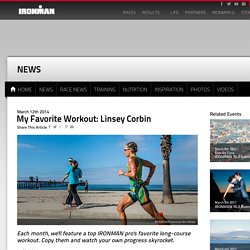
Her peppy running was last witnessed at the 2013 IRONMAN World Championship, where she snagged her third top-ten finish there with a 3:04 marathon. This workout will get the leg speed up from normal base running paces, and is a good way to set realistic pace goals for the season. As with any interval that starts fast and slows down, make sure to set smart pace goals so you can hold good form and run strong over the longer intervals. 3 Keys To Unlock A Run PR. Ironman legend Scott Molina once advised me to run every day.
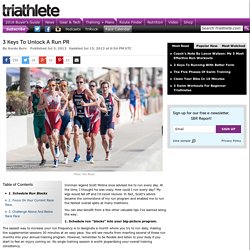
At the time, I thought he was crazy. How could I run every day? My legs would fall off and I’d never recover. In fact, Scott’s advice became the cornerstone of my run program and enabled me to run the fastest overall splits at many triathlons. One-Hour Workout: 4×1000 Track Session. Every Tuesday we’ll feature a different coach’s workout you can complete in 60 minutes (or less!). This week’s run workout comes from Bloomington, Ind. -based triathlon coach and Kinesiology/Sports Psychology Ph.D. Craig Paiement, who has been coaching since 1997. 4 Treadmill Sessions For Triathletes. Four purposeful workouts to help you use the treadmill to your training advantage. Whether you’re still waiting for spring to arrive or simply need more of a focus indoors, the treadmill is a useful tool to maximize your run training.
Coach Brad Seng of D3 Multisport in Boulder, Colo., designed these quality sessions to keep the fun factor intact for when the treadmill gets daunting or mentally stale. Warm-up 15’ easy jogging with 4×20’’ bursts and 40’’ easy for recovery at the end. Forget The Fads: Not All Running Tips Are True. The quick, trendy route to better performance seems more appealing than the long, traditional one, but you can’t shortcut your way to lasting results.
Our thoughts on running fads to ignore, along with some timeless advice on maximizing your triathlon run performance: Finding The Perfect Shoe 2011’s Born to Run started the barefoot and minimalist shoe movement, with believers scoffing at “traditional” running shoes. The truth: Minimalist shoes could work for you if you’re a healthy, lighter runner. But be cautious. The Perfect Cadence The idea that cadence is key to performance gains began with research by coach Jack Daniels at the 1984 Olympics. The truth: A slower cadence means longer, possibly higher strides, which can put you more at risk for injury because of the increased impact. 5 Important Running Stretches for Triathlon Training. Triathletes need to stretch. Although running will make your legs toned and strong, it will also make them tight.
Your quads, calves, hips, and hamstrings are forced to flex and extend over and over again with every step. Over time and many miles, these tendons and muscles begin to develop tension, scar tissue, and imbalances that can create overuse injuries, which can bring your triathlon training to a halt. Calculer sa VMA et allures de course. Ce logiciel permet : Séance entrainement 10 km semi marathon. Le travail à allure spécifique est nécessaire pour permettre au coureur d'exploiter pleinement son potentiel sur une distance donnée et de devenir plus efficace à l'allure de course visée. Voici comment l'organiser L’allure spécifique correspond à la vitesse moyenne réalisée sur une distance. Plan entrainement 10 km - 4 séances. L'objectif de cette page est de mettre en avant la démarche à suivre pour concevoir son propre plan d'entrainement 10 km du début à la fin. 1 - Définir la fiche identité du coureur.
Functional Form: 4 Fixes to Improve Your Running Mechanics. Illustration: Shawn O'Keefe More speed. Better efficiency. Fewer injuries. Bulletproof Your Run with Marching - IRONMAN Official Site. By Chris Johnson. Run 'Em Down. On the Longchamp Horse Track outside Paris in 1980, I watched Craig Virgin become the first, and only, American man to ever win the IAAF World Cross-Country Championships. Earlier that day in the junior men's race, I had battled the same long grass, log jumps, and unruly crowds—a spectator's German shepherd had nipped at my knee—and finished a respectable third.
Dispelling common run myths. I spend a lot of time interacting with my own community of runners, answering training questions, and participating in message boards. 5 Ways To Run Smarter. How to Train The Three Most Important Muscles in Running. Running, like any physical activity, involves coordination among a group of muscles to propel you forward. So singling out one of those muscles as the “most important” risks oversimplifying the process. Run Faster Off The Bike. Proper Pacing Will Make You a Better Runner. Ease inWhat's so bad about going out too fast? It depends on the distance, says Foster. How To Run More Efficiently.
60 minute session: 2km run repeats. High Quality Long Runs. Ask the coach: Run training. Three Running Workouts For The Treadmill. Biomechanical keys to better run form. Ask the coach: Run training. Run workout: 30-20-10 fartlek session. Confidence-building pro run workouts. Tempo Runs Increase Speed and Endurance. High Quality Long Runs. Sport Science Infographics by @YLMSportScience: Runners, never stop strength training before a competition! How To Run More Efficiently. 60 minute session: 2km run repeats.